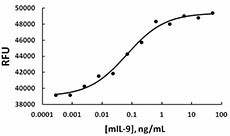- Regulatory Status
- RUO
- Other Names
- P40, MEA (mast cell growth enhancing activity), MCGF (Mast cell growth factor), TCGF-3 (T cell growth factor-3)

-

Recombinant mouse IL-9 induces proliferation of M-07e, a human megakaryocytic leukemic cell line, in a dose dependent manner.
| Cat # | Size | Price | Quantity Check Availability | ||
|---|---|---|---|---|---|
| 556002 | 10 µg | $223.00 | |||
| 556004 | 25 µg | $440.00 | |||
IL-9 was initially identified in mice as a T cell growth factor. Human and murine IL-9 show 56% amino acid sequence homology. IL-9 is a cytokine that acts as a regulator of a variety of hematopoietic cells, stimulates cell proliferation, and prevents apoptosis. The IL-9 receptor consists of the cytokine-specific IL-9 receptor α-chain (IL-9Rα) and the common γ-chain that is shared by IL-2, IL-4, IL-7, IL-15 and IL-21. IL-9 is expressed by activated Th9, Th17, Treg, and mast cells and appears to play important roles in the development and function of subsets within the CD4+ T cell lineage. IL-9 also inhibits immune responses by enhancing the suppressive properties of Tregs and by recruiting immune suppressive mast cells to sites of inflammation. Genetic studies on a mouse model of asthma demonstrated that this cytokine is a key factor in the pathogenesis of bronchial hyperresponsiveness. In this sense, it has been described that IL-9 and IL-9R expression are increased in lungs of asthmatic patients. In addition, IL-9 promotes mast cell mediated intestinal permeability and plays a role in the development of food allergies. Also, IL-9 has been associated with atopic dermatitis.
Product Details
- Source
- Mouse IL-9, amino acids (Gln19-Pro144) (Accession# NP_032399), was expressed in insect cells.
- Molecular Mass
- The 125 amino acid recombinant protein has a predicted molecular mass of approximately 14 kD. The DTT-reduced protein migrate as multiple bands between 17-25 kD by SDS-PAGE due to different glycosylation. The predicted N-terminal amino acid is Gln.
- Purity
- >95%, as determined by Coomassie stained SDS-PAGE.
- Formulation
- 0.22 µm filtered protein solution is in PBS.
- Endotoxin Level
- Less than 0.1 EU per µg of protein as determine by the LAL method.
- Concentration
- 10 and 25 µg sizes are bottled at 200 µg/mL.
- Storage & Handling
- Unopened vial can be stored between 2°C and 8°C for up to 2 weeks, at -20°C for up to six months, or at -70°C or colder until the expiration date. For maximum results, quick spin vial prior to opening. The protein can be aliquoted and stored at -20°C or colder. Stock solutions can also be prepared at 50 - 100 µg/mL in appropriate sterile buffer, carrier protein such as 0.2 - 1% BSA or HSA can be added when preparing the stock solution. Aliquots can be stored between 2°C and 8°C for up to one week and stored at -20°C or colder for up to 3 months. Avoid repeated freeze/thaw cycles.
- Activity
- Mouse IL-9 induces proliferation of MO7e cells. The ED50 is 0.04 - 0.16 ng/ml, corresponding to a specific activity of 6.5 - 25.0 x 106 units/mg.
- Application
-
Bioassay
- Application Notes
-
BioLegend carrier-free recombinant proteins provided in liquid format are shipped on blue-ice. Our comparison testing data indicates that when handled and stored as recommended, the liquid format has equal or better stability and shelf-life compared to commercially available lyophilized proteins after reconstitution. Our liquid proteins are verified in-house to maintain activity after shipping on blue ice and are backed by our 100% satisfaction guarantee. If you have any concerns, contact us at tech@biolegend.com.
- Product Citations
-
Antigen Details
- Structure
- Monomer
- Distribution
- Th2 cells, mast cells, activated Th9, Th17, and Treg cells.
- Function
- Autocrine growth and activation factor for Th17, Tregs, and mast cells. IL-1, histamine, and LPS induce the expression of IL-9 in mast cells. IL-9 is induced synergistically by IL-2, IL-4, and TGFβ and inhibited by IFNγ in naïve CD4 T cells.
- Interaction
- T helper cells, Th9, Th17, Tregs, human airway smooth muscle cells.
- Ligand/Receptor
- IL-9R complex (IL-9Rα and γ chain)
- Bioactivity
- Mouse IL-9 induces proliferation of M-07e cells.
- Cell Type
- Hematopoietic stem and progenitors
- Biology Area
- Cell Biology, Stem Cells, Immunology
- Molecular Family
- Cytokines/Chemokines
- Antigen References
-
1. Goswami R. and Kaplan MH. 2011. J. Immunol. 186:3283.
2. Kaiko GE. and Foster PS. 2011. Curr. Opin. Allergy Clin. Immunol. 11:39.
3. Townsend JM. et al. 2000 Immunity 13:573.
4. Mock BA. et al. 1990. Immunogenetics. 31:265.
5. Tan C. et al. 2010. J. Immunol. 185:6795.
6. Jager A. et al. 2009. J. Immunol. 183:7169.
7. Sismanopoulos N, et al. 2012 PLoS One 7(3):e33271. - Gene ID
- 16198 View all products for this Gene ID
- UniProt
- View information about IL-9 on UniProt.org
